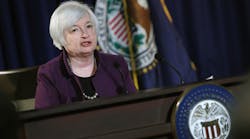Fed: Cheaper Imports, Falling Energy Prices Keep Interest Rate Unchanged
WASHINGTON—The Federal Reserve kept its benchmark federal funds interest rate unchanged at near-zero percent as expected Wednesday, providing no fresh hints on when a long-awaited rate rise might come.
The Federal Open Market Committee said the U.S. economy had expanded "moderately" in recent months and the jobs market had strengthened, but noted continued "soft" business investment and exports.
It also said that inflation remained softer than monetary policy makers want to see, though noting that much of the weakness is related to the plunge in energy prices over the past year and to cheaper imports, thanks to the strong dollar.
But the FOMC's brief policy statement, at the end of a two-day meeting, gave no fresh sign of their thinking on when they will embark on an expected series of rate increases.
Minor changes in the language of the statement showed only that "the past six weeks data pushed the FOMC a little closer to raising rates," said economist Chris Low of FTN Financial.
"But they are still waiting for more good news before they actually pull the trigger," he said.
The fed funds rate has been held at zero to 0.25% since late 2008 to help bring the U.S. economy back from deep recession, and Fed Chair Janet Yellen has said twice this month that she expects a rate hike will come by the end of the year.
An increase was not expected at this week's meeting, as recent data, while good, has not been strong enough to completely convince FOMC members that the economy is ready for it.
But some thought the panel might tip their hand by changing some of the language in the statement.
Instead, the Fed has made clear it wants to see what the two monthly employment reports and other various data updates show before its next meeting, on September 16-17.
Waiting for More Data
Despite some calls to hold off until 2016, FOMC members appear anxious to break the ice with the first increase, even as they assure markets that increases after that are likely to come in slow steps.
Key data has recently been closer to what the Fed said it wants to see to "normalize" monetary policy after years of easy money.
The unemployment rate fell to 5.3% in June, from 10% at the 2009 peak.
Inflation, as measured by core consumer prices, picked up to 1.8% in June year-over-year, nearing the FOMC target of around two percent.
While expressing confidence in a pickup in economic activity in the second half of the year, Yellen has also singled out some weaknesses that leave her less than convinced about the coming months.
In July comments, she pointed out that the labor force participation rate is still extremely low at 62.6%; that part-time employment remains high; and that wage growth remains slow despite strong job creation, suggesting that there remains significant slack in the jobs market.
WORKFORCE WATCH ENEWSLETTER:
Sign up for the IndustryWeek Workforce Watch Weekly Newsletter
The FOMC statement reiterated that raising rates will be appropriate "when it has seen some further improvement in the labor market and is reasonably confident that inflation will move back to its 2% objective over the medium term."
"The Fed, as usual, is keeping its options open," said Pantheon Macroeconomics economist Ian Shepherdson.
"Not much more improvement is needed, keeping the door to a September hike open," he said, but it will mostly be contingent on the next two employment reports.




